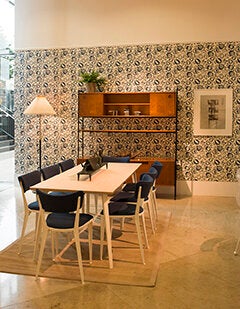The Pangolin London has transformed itself into a time capsule for the next few weeks with its exhibition Sculpture in the Home. The show consists of three rooms exquisitely decked out in furniture, drawings, textiles, wallpaper and sculpture dating mainly from the 1940s and 1950s. The inspiration for the exhibition comes from a selection of touring shows put on by the Arts Council at that time. They featured both the work of established artists such as Henry Moore and Barbara Hepworth, as well as young emerging talents such as Geoffrey Clarke, Lynn Chadwick and Reg Butler. In fact, they were something of a showcase for British talent, which was recognised more on the continent than at home. Sculpture in the Home is not a re-creation of these exhibitions but a reinterpretation, including different works by nearly all of the artists originally featured in the tours. These have been assembled through families, dealers or from companies like Sanderson that have reissued their '50's archive.

In one room (above) for example, two Reg Race Wingback chairs stand near a G Plan coffee table all placed on a Mourne Textiles rug that took six weeks to weave. Opposite is another Reg Race Wingback sofa adorned with Lucienne Day-designed cushions. Sanderson wallpapers adorn the walls, floating above is a Lynn Chadwick mobile and scattered upon furniture by craftsman Robin Day, are sculptures by Geoffrey Clarke, Leon Underwood, Rosemary Young, Bernard Meadows and many more. According to curator Polly Bielecka, "This period was a unique period in history where a new visual language can be seen across both art, design and architecture."
The idea of placing small sculptures in a domestic setting came about because of the difficulty of transporting large exhibits around the country in the aftermath of the war. In fact, the war made a huge impact on sculpture during this period. The scarcity of wood due to military demands forced artists to look at new ways to create their art. Aluminium furniture became fashionable as a result. This transferred itself to sculpture where new materials like iron began to be used. Chadwick and Clarke both attended a welding course together and both had architectural backgrounds rather than an art education. Two million homes were destroyed during the war, 60% in London, and the home became once again a focus for design and manufacturing as furniture had to be replaced. Artists and designers were aided by the Furniture Utility Scheme set up by the government to offer quality furniture that could be mass-produced. The Arts Council's brief was to help stimulate the British art market and the pieces then, as with this exhibition too, were for sale.

Sculpture in the Home not only offers an insight into the ways sculptors crossed disciplines - Chadwick, Paolozzi and others here feature in drawings, paintings and sculptures - it also reflects a period which saw a transition between representational and abstract art. "There was also a vibrant cross-collaboration," says Polly Bielecka. "A Robin Day cabinet with a Geoffrey Clarke sculpture on top of it was used in an Edinburgh weaver's advertisement. Geoffrey Clarke also etched a panel for an impressive wall cabinet that Robin Day showed at the Milan Triennale."
What struck me in particular about so many of the exhibits is their modern look. There has been something of a revival in this period's fashion in furniture for example - wingback chairs are available in many a modern furniture store. Great care has been taken in both sourcing the works and an interior designer has been used to place them in the three rooms. The result is a refreshing context in which to view sculpture and a fascinating historical as well as aesthetic experience.
Sculpture in the Home is at Pangolin London, King's Place, 90 York Way, London N1 9AG until 17 May. The pictures are used with the permission of the gallery.